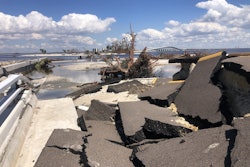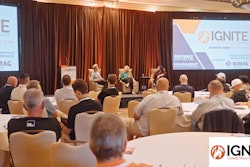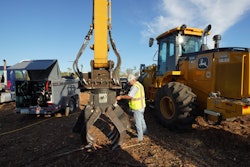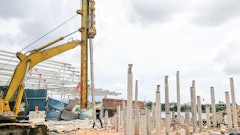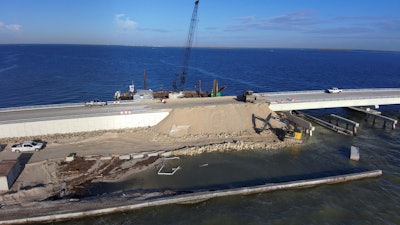
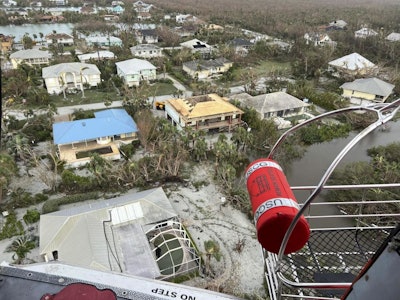 Courtesy of the U.S. Coast Guard
Courtesy of the U.S. Coast Guard
Assessing the Damage
Sanibel is not a large island, spanning about 12 miles, and home to only about 6,500 permanent residents. When the storm came a handful didn't evacuate, and were left stranded on the island when the bridge washed out. The governor of Florida, Ron DeSantis, was quoted by the New York Times the day after U.S. Coast Guard helicopters surveyed the damage, “It got hit with really biblical storm surge, and it washed away roads. It washed away structures.” In one area of the causeway, a fifty foot span of road collapsed into the bay.
“The Sanibel Causeway was affected when the land that the road was built on was washed away,” said Florida DOT Secretary Jared Perdue. “A bridge stability analysis will be performed, and repairs needed range from repairing bridge approaches to restoring the roadway across most of the causeway.”
When asked about the structural failures, Ryan Hamrick, the division manager for Superior Construction, one of two contractors brought in to work on the project, said, "There has been a lot of investigating of that. FDOT took a lot of samples and a lot of data to determine what to tweak or modify for future designs, especially in coastal areas."
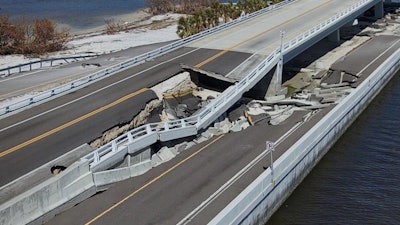 Before, Island Bridge 1 ApproachProvided by Superior Construction
Before, Island Bridge 1 ApproachProvided by Superior Construction
Hamrick was part of the earliest groups of people brought in to evaluate the work that would need to be done. "My role is to really just help the team and be a resource to them. I worked to assemble people, explained to them what the issues were, and then kind of backed up, letting them be the hands on on the job."
He brought with him a lot of crucial experience. "I've been in this business for about 23 years, including six years in this current role, and I’ve been working in Florida since day one. I’ve been a part of emergency repair projects over the years, but none compare to this one in terms of size and magnitude."
The pictures that went online, focused heavily on the sunken parts of the road, but there was some good news when Hamrick arrived. "The structure itself faired the storm pretty well, actually. The causeway was the part that took the brunt of the damage. The MSE (mechanically stabilized earth) walls surrounding the approach slabs were washed out by the storm surge, causing the slabs to fail. We broke those slabs up, got them out of the way, and then refilled the sections leading up to the bridge."
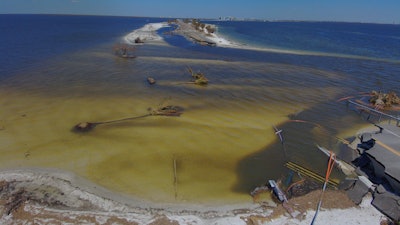 Before, Island 2 BreechProvided by Superior Construction
Before, Island 2 BreechProvided by Superior Construction
In the immediate days following the disaster, the three mile roadway connecting Sanibel to the mainland was a high priority. With tens of thousands effected statewide, there was still a sense of urgency, and optimism, around these specific repairs. The mayor of the small island community Holly D. Smith wrote in an open letter, "Sanibel is an amazing and resilient community that will no doubt come together to emerge from this challenge better than ever." And the community really has come together.
A Joint Venture, A Singular Resolve
On October 5, less than a week after the storm passed through, FDOT announced a combined team, made up from Superior Construction and de Moya Group crews, had been awarded the contract to restore the failed sections of bridge. At first, it was announced publicly that it would reopen by the end of the month of October. That was seen as an ambitious timeline when the working conditions and the amount of resources required were taken into consideration. The availability of resources is already a difficult issue for construction projects, even when conditions are ideal.
"This job is certainly different than your normal job. The emergency nature of putting a team together very quickly, to be able to respond and get work done safely, and in a very expeditious manner. It's definitely unique," Hamrick said of the difficulties the crews have faced. "Our main focus, obviously, is to reconnect people to the community of the island and Sanibel and Captiva seeing that the dire straits people were in with not having access when we first got there a few days after the storm passed away, it was pretty daunting."
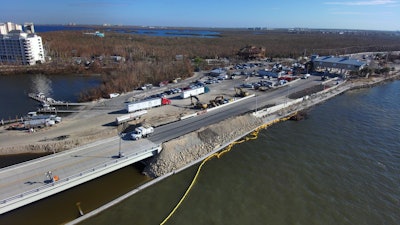 After, Bridge Approach AProvided by Superior Construction
After, Bridge Approach AProvided by Superior Construction
Factors that, on non-emergency jobs, are usually fair routine, in this case are much more complicated. "Everything's a challenge in a job like this. Getting to the job, there's no power, the lights are out, the traffic signals aren't working. It takes so long just to get to the to the worksite itself. Project logistics like the number of boats it takes to get people equipment there. Not to mention, after a devastating event like Hurricane Ian, the resources are just strung out and hard to get there. Even something as simple as crew accommodation, like where they're going to sleep tonight or take a shower. Are we gonna get them enough food? All those were monumental challenges that we had to face from the minute we stepped on the site."
The good news is that relief workers, support teams, and everyone else, it seems, banded together in a best case scenario. The focused effort paid off, because the Sanibel causeway reopened on October 19, completing enough repairs to reopen to residents more than a full week ahead of the exceedingly ambitious deadline. But how was this made possible?
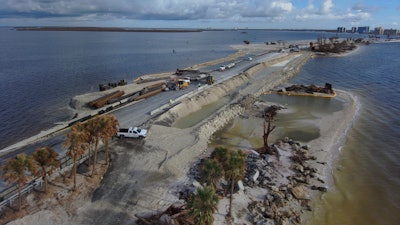 After, Island 1 BreechProvided by Superior Construction
After, Island 1 BreechProvided by Superior Construction
As Hamrick put it, "Everyone was working in the same direction together. It was a truly collaborative effort across the entire team, and I’m not just talking about the Superior crews. Our JV partner, our designers, FDOT’s representatives and consultants, emergency responders, police officers — everyone was aiming towards the same goal."
Build By Numbers
In a press release published by Superior Construction, following the completion of the first phase of repairs, they reported that all of the teams across the various organizations worked more than 36,000 combined workforce hours to bring residents back to Sanibel Island in just 15 days. Now, its crews will shift their focus to long-term repairs needed to stabilize the bridge and allow permanent and unlimited access to the island. These repairs are necessary to rebuild the community so local businesses can thrive once more, as the island’s economy heavily relies on tourism.
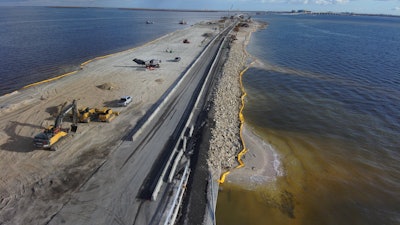 After, Island 2 BreechProvided by Superior Construction
After, Island 2 BreechProvided by Superior Construction
According to FDOT, completing the temporary repairs required:
- More than a hundred crews
- 70 pieces of heavy equipment
- Four barges, five boats and two dredges
- Seven cranes
- Dive teams with underwater survey equipment
- 8,200 loads of fill dirt
- 2,400 loads of rocks
- 4,000 tons of asphalt
With traffic access restored, it does come with some restrictions and limitations. There's a lot of work that needs to be done, and coordinating those efforts could be complicated with an increased civilian presence. According to Lee County's website, in cooperation with the Federal Emergency Management Agency (FEMA), Monday and Tuesday of each week the island will only be open to essential personnel. The rest of the days residents, business and property owners, and private contractors will be allowed access during a limited window each day, followed by a strict 9:00pm curfew.
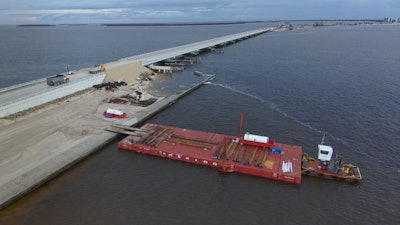 During, Bridge Approach BProvided by Superior Construction
During, Bridge Approach BProvided by Superior Construction
How will the traffic effect Superior's crews as they continue to work on the next phase of repairs to the causeway? "We don’t really know how the county and how the island will be affected by traffic yet or how the flow of traffic will be,” Hamrick said. “Either way, we’ll work around that however necessary to minimize the impact on traffic, if any."
Of the two open inbound lanes, one will be dedicated solely for civilian, non-essential vehicles, and the other exclusively for the government contract workers, crews and vehicles. The Sanibel community still has a long way to go towards its full recovery. Every corner of the island was impacted. Thanks to the tireless work of Superior Construction, de Moya Group, and countless others, that long road to restoration can now proceed with real earnest. Every construction project that takes place from here on out, owes a debt to the speed at which the causeway was reopened.





